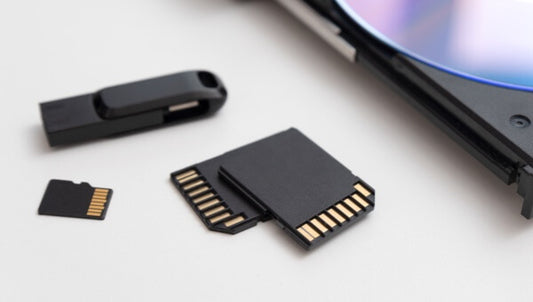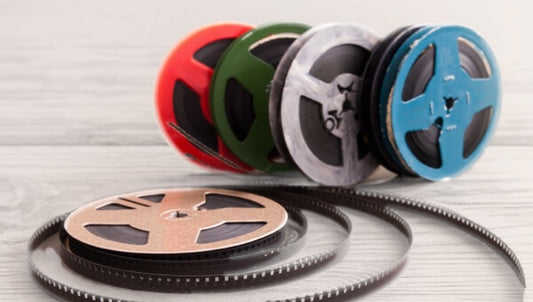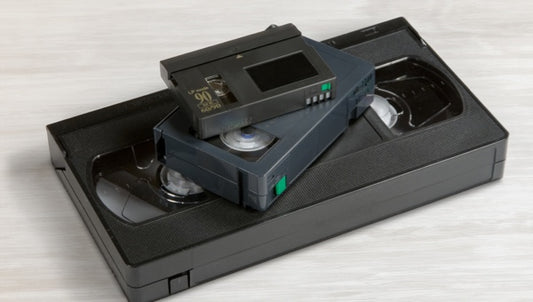Few home video format debates are as iconic as LaserDisc vs DVD. Both left a lasting impact on how we watched movies at home. Capture will compare LaserDisc and DVD in terms of resolution, quality, and technology. Learn how each format performed, their strengths and weaknesses, and why DVDs eventually became the standard while LaserDiscs gained cult status.
Jump to:
What Is LaserDisc?
LaserDisc debuted in 1978 as an alternative to VHS tapes, offering superior picture and sound quality. Unlike VHS, which used magnetic tape, LaserDiscs stored video optically on large, 12-inch discs - similar in size to vinyl records.

How LaserDisc Worked
LaserDiscs encoded video using an analog signal but supported digital and analog audio. This gave them a unique advantage over VHS in terms of picture sharpness and sound fidelity. However, the format had a few downsides:
- Large disc size: At 12 inches in diameter, LaserDiscs were bulky and required significant storage space.
- Limited capacity per side: A standard LaserDisc could hold about 60 minutes of video per side, meaning longer movies required multiple discs or manual flipping.
- Expensive players: LaserDisc players were costly, making the format less accessible to the average consumer.
Why LaserDisc Was Popular Among Cinephiles
Despite these limitations, LaserDisc gained a dedicated following. Movie enthusiasts and collectors appreciated its higher video quality and ability to include director’s commentaries, behind-the-scenes footage, and alternate audio tracks - features that were unavailable on VHS at the time.
What Is DVD?
DVD is short for Digital Versatile Disc. DVDs was introduced in 1996, designed to replace both VHS and LaserDisc by offering higher-quality video in a much smaller, more efficient format. Unlike LaserDiscs, DVDs were fully digital, storing compressed video and audio data with advanced encoding techniques.
DVD’s Key Advantages
- Compact size: At just 4.7 inches in diameter (same as CDs), DVDs were far more convenient than LaserDiscs.
- Higher storage capacity: A standard single-layer DVD could hold 4.7GB of data—enough for a full-length movie with multiple audio tracks and special features.
- Enhanced video quality: DVDs supported 480p resolution with digital encoding, resulting in a sharper, cleaner image compared to LaserDisc’s analog format.
- Surround sound support: Advanced Dolby Digital and DTS audio formats made DVDs ideal for home theater setups.
- Interactive features: Unlike LaserDiscs, DVDs included interactive menus, chapter selection, subtitle options, and bonus content—all easily accessible without needing to flip or swap discs.
How DVD Replaced LaserDisc and VHS
Thanks to its affordability, superior quality, and convenience, DVD quickly became the dominant home video format. Within a few years, it replaced both VHS and LaserDisc, leading to widespread adoption by major studios and consumers alike.

LaserDisc vs DVD: Resolution and Quality
To understand the difference, we can start by comparing LaserDisc resolution vs DVD resolution.
- LaserDisc: Analog video with 425 lines of resolution (NTSC).
- DVD: Digital video with 480p resolution, offering a clearer, more stable image.
While LaserDiscs provided better visuals than VHS, they still had limitations compared to DVD’s digital precision and consistency.
Analog vs Digital Video
One advantage of LaserDisc’s analog signal was its smooth motion and color reproduction, which some viewers found more natural. However, analog video could degrade over time and was prone to artifacts such as:
- Color bleeding
- Image noise
- Signal degradation
DVDs, being digital, eliminated these issues and offered a sharper image without degradation. The use of MPEG-2 compression allowed for better clarity and efficient storage, making DVDs more practical for mainstream consumers.
LaserDisc vs DVD - Audio Quality
LaserDisc introduced digital audio before DVDs, allowing for higher-fidelity sound than VHS. Many LaserDiscs featured CD-quality stereo audio or even Dolby Digital 5.1 surround sound.
However, DVD surpassed LaserDisc by supporting:
- Advanced multi-channel formats (Dolby Digital, DTS, and later, Dolby TrueHD).
- Higher bitrates for cleaner, more immersive sound.
For home theater enthusiasts, DVD’s support for full surround sound gave it a significant advantage over LaserDisc.
LaserDisc Players vs DVD Players
LaserDisc player limitations:
- Bulky design: LaserDisc players were large and took up significant space.
- Manual disc flipping: Most LaserDisc movies required manually flipping the disc halfway through playback. Some advanced players featured auto-flipping, but this added to the cost.
- Limited features: Unlike DVD players, LaserDisc players lacked modern conveniences such as chapter skipping or scene selection.
DVD players eliminated the need for flipping discs and provided seamless playback features, including:
- Instant scene selection
- Multiple audio tracks
- Fast-forward, rewind, and slow-motion functions
Their backward compatibility with CDs also made them a versatile entertainment device, further driving adoption.
Why LaserDiscs Are Still Collected Today
Even though DVDs replaced LaserDiscs, the format retains a cult following among collectors. Some LaserDisc editions remain valuable because they feature:
- Exclusive artwork and packaging
- Uncompressed video and audio tracks
- Rare director’s commentaries and bonus content
However, LaserDiscs suffer from disc rot, a condition where the aluminum layers oxidize, leading to playback issues over time. This has made some LaserDiscs rare and highly sought after by collectors.
How DVDs Revolutionized Home Entertainment
DVDs, on the other hand, became the definitive home video format for nearly two decades before the rise of Blu-ray and streaming. Their impact on the industry was enormous, introducing:
- Affordable, high-quality home media
- Interactive features that enhanced user experience
- Widespread accessibility, making movies easier to own and enjoy

The Final Verdict - Which Format Was Better?
LaserDisc’s Strengths
- Better video quality than VHS
- Early digital audio support
- Collector appeal with large packaging and unique releases
DVD’s Strengths
- Compact and durable format
- Higher resolution and better compression
- More user-friendly features like menus and scene selection
- More affordable and widely adopted
Ultimately, DVD’s superior technology, affordability, and convenience led to its dominance. However, LaserDisc’s legacy as a pioneering high-quality format remains, and it continues to be treasured by dedicated collectors.
Preserving Classic Media - The Importance of Digital Transfers
Both LaserDiscs vs DVDs, while revolutionary in their time, are physical media that degrade over time. To ensure your collection stays accessible, consider digitizing your DVDs and LaserDiscs. This allows you to preserve rare releases while enjoying movies on modern devices without worrying about disc damage.
Capture specializes in professional DVD transfer to digital, helping you keep your home movie library safe for the future.










